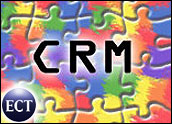
What is the potential opportunity for Web 2.0 technologies in the enterprise space? A whopping US$4.6 billion a by 2013, according to a tally Forrester Research arrives at in a report released earlier this year. Spending on Web-based enterprise technologies, including social networking, RSS (really simple syndication), blogs, wikis, mashups, podcasting and widgets will grow by 43 percent each year for the next five years, the firm predicts.
The customer relationship management industry is a natural supplier for this next tech evolution. At bottom, Web 2.0 technologies have come to represent a fundamentally new way to connect — and even collaborate — with customers, prospects, employees, partners and suppliers.
CRM vendors have taken note.
Recent examples run the gamut from the acquisition of Talisma to the mini Web 2.0 apps Oracle has been releasing to enhance its CRM platform to the recent release of Acrobat v. 9, which offers native support of Flash along with a beta release of online tools designed to enhance collaboration.
Then there is Salesforce for Google Apps, a product that combines Google’s budding suite of productivity applications with the ubiquitous on-demand customer relationship management application.
SAP is redoubling its commitment to Web 2.0, as evidenced by numerous blog and analyst reports following its recent Sapphire conference.
Still Not Enough?
Despite all of these efforts, there is a pervasive concern that not enough CRM companies are making the necessary ground-up, internal changes to develop truly collaborative and interactive tools.
The results of her firm’s recent survey of several enterprise vendors about their level of Web 2.0 adoption were disappointing, reported Maggie Fox, principal with Social Media Group.
“All firms are clearly thinking about it,” she told CRM Buyer, “but few have a big institutional push” to develop these technologies.
Ranking the companies on the basis of Web 2.0 adoption across the enterprise, its integration in the product suite, and such metrics as unofficial employee engagement, Social Media found that Microsoft — which has not developed much cred in this space — was in the lower 50 percentile, Fox said. More worrisome was the fact that most of the vendors in her survey were trailing Microsoft.
There are any number of reasons for this gap — whether real or perceived — between demand for the tools and actual delivery by vendors. They range from the tools’ newness to their tricky economics.
“I think we are at beginning of the opportunities that can be had from integrating Web 2.0 tools into CRM,” Rebecca Wettemann, vice president of Nucleus Research, told CRM Buyer.
It’s not so much that vendors are disinclined to make the necessary investments in their products. Rather, she said, the industry is still at the beginning of the learning curve in determining which functions are most valuable to the enterprise.
“Consider social networking,” Wettemann said. “It is very important to know how a new prospect or contact is related to your company or the industry. But knowing when and about what that person last Twittered? Not so much.” The challenge is for vendors to balance the benefits of Web 2.0 with their distractions.
Also, many Web 2.0 tools are already free, as the Forrester Report points out. Enterprise versions are likely to be commoditized as well.
IBM Leads
Interestingly, given that it’s an established tech company from an earlier generation, IBM appears to be at the top of its Web 2.0 game. It was the highest-ranking firm in the Social Media survey, placing in the top 20 percentile.
By most metrics — from its product rollout to enterprise strategy to even cultural heros — IBM is making all the right moves, Louis Columbus, an analyst with Cincom, told CRM Buyer.
For starters, IBM has five major initiatives underway to accentuate collaboration within and between groups, he said, ticking them off.
“Most significant is Lotus Connections, a Web-based app that is quite good. There’s also Lotus Quickr, which has been specifically designed for intergroup collaboration and document sharing. WebSphere Portal, a mainstay of the company’s direction with regard to collaborative technologies, has been designed to include support for WorkPlace.”
Finally, Columbus concluded, IBM has been working on integrating instant messaging into its applications as well, via Lotus Sametime.
“IBM is working to create a single platform on which they can provide social networking, collaborative process, and enterprise content management integration,” he said. “WebSphere’s role as an SOA (service-oriented architecture) is going to be solidified by these strategies as well.”
Even its corporate heroes are Web 2.0-savvy, Columbus added. “Andrew McAfee is a professor at Harvard and the guy who coined the term ‘Enterprise 2.0.’ IBM thinks this guys rocks and has really captured the essence of how companies will adopt Web 2.0 technologies. In fact, IBM is saying that enterprise-level mash-ups could eventually happen from the concepts inherent in Enterprise 2.0.”
For all the products it has rolled out, it is that last factor that Social Group’s Fox considers most telling — both for ranking IBM and as a guide for selecting the best vendor of a particular tool set.
“Always look at the firm’s holistic approach,” she advised. “Is it doing things like encouraging employee engagement, participating in industry collaborative projects and so on?”
The industry is too new, said Fox, to cite more tangible benchmarks for buying companies.
























































